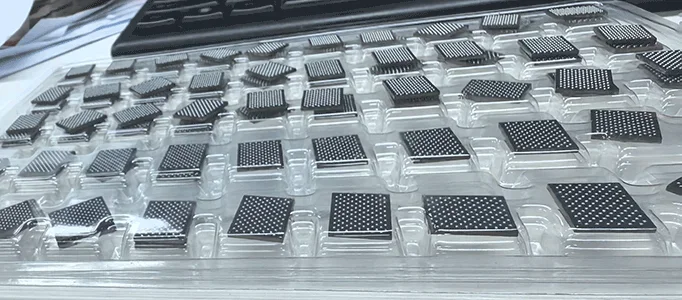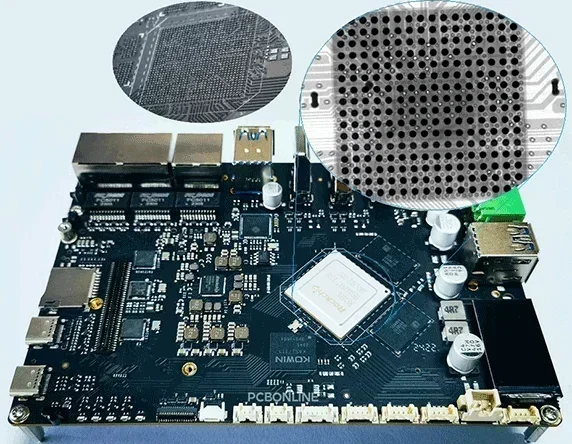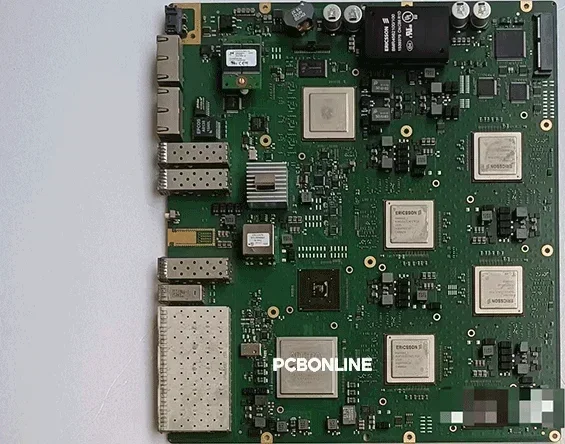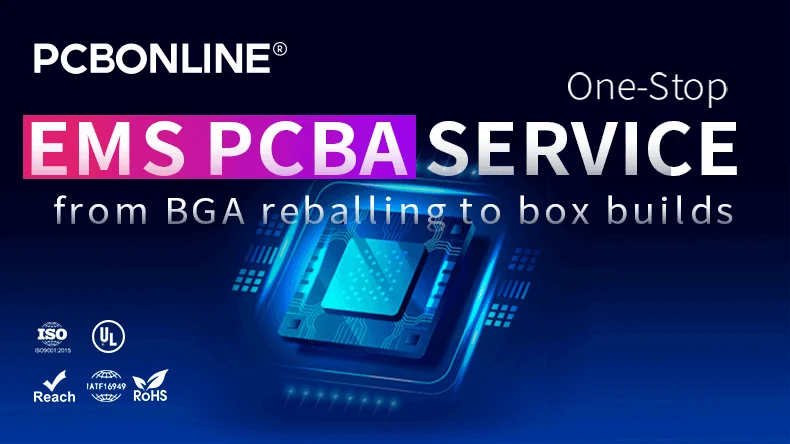
As electronic devices become smaller, faster, and more powerful, the ball grid array (BGA) package has become one of the most important IC packaging technologies. BGA packages enable high-density interconnections and excellent electrical performance for processors, GPUs, FPGAs, and AI chips.
BGA ball pitch, the distance between the centers of adjacent solder balls, directly affects how dense the connections can be, how complex the PCB must become, and how precise the assembly process must be.
PCBONLINE, a turnkey HDI PCB manufacturer for AI servers and high-speed devices, provides BGA PCB manufacturing and assembly, as well as BGA reballing and procurement. In this article, we will explain what BGA ball pitch means, review common BGA pitch sizes such as 0.3mm, 0.35mm, 0.4mm, 0.5mm, 0.65mm, 0.8mm, and 1.0mm, and discuss the requirements for PCB manufacturing and SMT assembly for fine-pitch BGAs.
What Is BGA Ball Pitch?
BGA ball pitch refers to the center-to-center distance between adjacent solder balls on the underside of a BGA package. The common BGA pitches include 0.3mm, 0.35mm, 0.4mm, 0.5mm, 0.65mm, 0.8mm, and 1.0mm.
BGA pitch affects:
- PCB routing design — smaller pitch requires finer traces and microvias.
- Manufacturing cost and difficulty — tighter pitch means more HDI layers and advanced fabrication.
- Assembly accuracy — the pick-and-place and reflow processes must be extremely precise.
- Reliability — fine-pitch BGAs are more sensitive to warpage, misalignment, and voiding.
0.8mm and 1.0mm are standard BGA pitches.
Fine pitches are ≤ 0.65mm.
Ultra-fine pitches are ≤ 0.35mm.
A smaller pitch means more I/O pins can fit into the same chip size, which increases data bandwidth and integration density. However, it also makes the PCB layout, soldering, and inspection significantly more challenging.

Common BGA Ball Pitch Sizes
Different BGA ball pitches are suitable for different performance and size requirements. Let's explore the most common BGA pitch sizes and their typical applications.
1.0mm-pitch BGA
1.0mm is a standard BGA pitch size, easy to manufacture, inspect, and rework. It is found in CPUs, ASICs, and power management ICs that require strong mechanical reliability and robust solder joints.
Because of the larger ball spacing, standard FR4 multilayer PCBs with through-hole vias are sufficient, without the need for microvias or via-in-pad structures.
0.8mm-pitch BGA
The 0.8mm-pitch BGA bridges the gap between traditional and high-density designs. It provides higher interconnect density while remaining cost-effective and reliable.
A 0.8mm pitch is used in consumer electronics, industrial controllers, and communication systems, where compact form factors and balanced assembly yield are important.
0.65mm-pitch BGA
The 0.65mm pitch marks the beginning of the fine-pitch BGA category. At 0.65mm spacing, PCB layout becomes more complex, and HDI (High-Density Interconnect) technology is usually required. Designers often adopt laser-drilled microvias or via-in-pad with copper filling to properly fan out the dense signal pads.
The 0.65mm pitch is common in networking equipment, compact computers, and automotive electronics that require higher integration.
0.5mm-pitch BGA
The 0.5mm-Pitch is a popular fine-pitch BGA size used in mobile devices, GPUs, SSD controllers, and embedded systems.
At 0.5mm spacing, solder mask alignment, stencil design, and reflow temperature control are critical to avoid bridging and open solder joints. PCB manufacturers like PCBONLINE use high-precision SMT equipment with ±25μm placement accuracy and Type 5 or finer solder paste to ensure perfect soldering quality.
0.4mm-pitch BGA
0.4mm is the most common fine-pitch choice for smartphones, AI accelerators, and high-performance GPUs. 0.4mm-pitch BGA HDI PCB manufacturing, requiring laser microvias, copper-filled via-in-pad, and ENIG or ENEPIG surface finishes.
At the 0.4mm fine-pitch, the reflow process must be optimized carefully to prevent warpage and excessive voiding.
0.35mm-pitch BGA
0.4mm BGAs push the limits of HDI PCB manufacturing. Entering the ultra-fine-pitch range, 0.35mm BGAs are used in high-end GPUs, CPUs, and advanced AI processors where space efficiency and high-frequency signal integrity are crucial.
Manufacturing 0.35mm PCBs requires precise layer registration and surface planarity control. PCBONLINE's HDI PCBs with copper-filled microvias ensure stable electrical performance and excellent solder joint reliability for 0.35mm BGA components.
0.3mm-pitch BGA
0.3mm is currently the smallest and most advanced BGA-pitch size. It is used in 3D ICs, chiplet interconnects, and next-generation AI processors. Achieving 0.3mm BGA assembly demands extreme precision, including highly accurate placement machines, nitrogen reflow systems, and flawless PCB surface flatness. Currently, 0.3mm-pitch BGA assembly is only used for PCB prototypes, not available for bulk production yet.

PCB and SMT Requirements for Fine-Pitch BGA
As the BGA-pitch becomes smaller, BGA PCBs require PCB manufacturers like PCBONLINE to have capabilities in achieving HDI PCB structures, via-in-pad technology, advanced surface finishes, and ultra-precise SMT assembly.
HDI design and layer count
Fine-pitch BGA PCBs are usually HDI multilayer PCBs with laser microvias and stacked vias. PCBONLINE provides:
- 4- to 64-layer PCBs
- Any-layer interconnection (ALIV) capability
- Copper-filled microvias for via-in-pad designs
Via-in-pad technology
Via-in-pad allows signals to escape directly under the BGA balls. After drilling, vias are filled and planarized with copper, ensuring smooth surfaces for assembly.
Surface finish
ENIG (Electroless Nickel Immersion Gold) is standard for BGAs because it ensures flatness and oxidation resistance.
Impedance control
High-speed BGAs like GPUs and CPUs require controlled impedance traces to maintain signal integrity, especially for DDR, PCIe, and HDMI interfaces.
Precision printing and placement
- Stencil thickness: 80–100µm
- Solder paste: Type 5 or Type 6 for ultra-fine apertures
- Placement accuracy: ±25µm or better
Reflow profile optimization
- Controlled ramp-up and soak stages to prevent warpage
- Peak temperature ~240°C for lead-free solder
- Vacuum reflow is optional for minimizing voiding (<5%)
Inspection
Since BGA joints are hidden, X-ray inspection is mandatory to check solder voiding, bridging, or missing balls, and ball alignment.

PCBONLINE performs 100% X-ray inspection for every BGA board to ensure IPC-A-610 Class 3 compliance.
Partner with PCBONLINE for BGA PCB Manufacturing and Assembly
At PCBONLINE, we provide one-stop PCB manufacturing and assembly for all types of BGA applications, from 1.0mm standard BGAs to ultra-fine 0.35mm and even 0.3mm packages.

Founded in 2005, PBONLINE has two large advanced PCB manufacturing bases and one PCB assembly factory.
Turnkey BGA PCBA services with BGA-pitch capability down to 0.35mm in mass production, 100% X-ray inspection, first-article inspection, and BGA reballing services for refurbished BGAs.
BGA soldering voiding control standard < 5% and can even go down to <3% with vacuum reflow soldering, exceeding industry standards.
Our HDI PCB fabrication of 4–64 layers with 1+N+1, 2+N+2, 3+N+3, and any-layer interconnect supports your BGA PCB requirements of any ball pitches down to 0.35mm.
Provide BGA baking and burn-in programming for free if each BGA programming takes within 30s.
Our professional engineers design the SMT stencil properly for BGA soldering and have rich experience in reflow and wave oven temperature control to reduce the risk of BGA soldering issues like warpage and excessive voiding.
Strict BGA PCBA quality standards with ISO 9001:2015, ISO 14001:2015, UATF 16949: 2016, IPC-A-610 Class 3, RoHS, REACH, and UL certifications.
We serve industries including computing, AI, telecommunications, automotive electronics, and industrial control. Whether you need GPU PCBs, CPU boards, or fine-pitch AI modules, PCBONLINE provides reliable one-stop manufacturing and assembly that ensures long-term reliability and performance. If you feel interested in BGA PCB and soldering from PCBONLINE, send your inquiry by email to info@pcbonline.com.
Conclusion
As electronic devices push toward miniaturization and higher integration, BGA ball-pitch continues to shrink, from 0.65mm down to 0.3mm. At PCBONLINE, we deliver turnkey BGA PCB solutions, from HDI PCB fabrication and fine-pitch BGA assembly to professional reballing services. You can have BGA procurement, BGA PCB manufacturing and assembly, and BGA reballing all solved by PCBONLINE, providing advanced capabilities and full-service manufacturing.
PCB assembly at PCBONLINE.pdf




